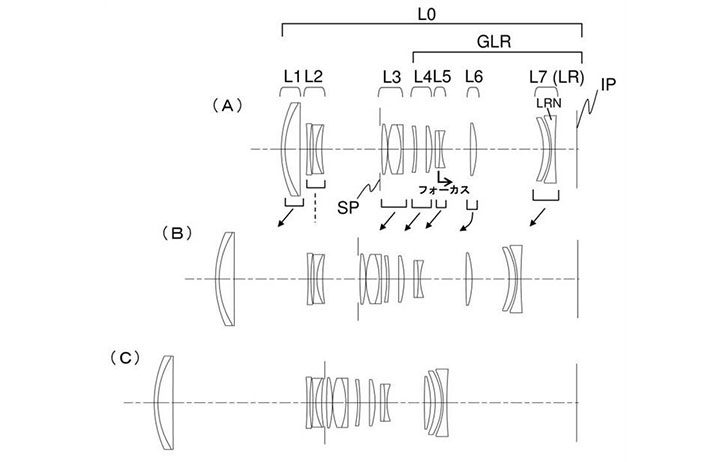More telephoto zoom lens patents for the RF mount have been uncovered by Canon News. A couple of them look to be “consumer” zoom lenses along with what is likely an L lens in the RF 100-400mm f/3.5-5.6L IS.
Japan Patent Application 2019-020679
Canon RF 100-400mm f/3.5-5.6L IS USM
- Focal distance 102.21 195.97 389.86
- F number 3.83 4.93 5.85
- Half angle of view (degree) 11.95 6.30 3.18
- Image height 21.64 21.64 21.64
- Lens total length 204.85 250.29 291.30
- BF 4.31 31.68 97.49
Canon RF 70-300mm f/4-5.6 IS
- Focal distance 68.25 126.36 288.22
- F number 4.16 4.68 5.83
- a half field angle (degree) — 17.59 9.72 4.29
- Image height 21.64 21.64 21.64
- Whole length of the lens 168.24 189.04 207.81
- BF 12.70 30.65 79.58
Canon RF 50-250mm f/4-5.6 IS
- Focal distance 51.80 126.89 241.22
- F number 4.04 5.18 5.77
- a half field angle (degree) — 22.67 9.68 5.13
- Image height 21.64 21.64 21.64
- Whole length of the lens 136.91 175.70 210.70
- BF 11.36 30.93 42.48
Some of our articles may include affiliate links. If you purchase through these links, we may earn an affiliate commission at no extra cost to you.


For my work, it will be perfect. With the R sensor, the need for 2.8 is greatly diminished.
What is the advantage of using a native RF mount telephoto lens compared to using an EF telephoto of same focal length and aperture with an EF-RF adapter? There shouldn't be any advantages in terms of the length or width of the lens. Perhaps better mechanical stability and slightly less weight?
The biggest problem with the R series cameras is the lack of an RF to EF-M adapter. I have been planning a jump to full frame at some point, and have several EF lenses as a result. Upward compatibility has always been a strength in the Canon line. It's nice to know that I can use those lenses now (and I do) while I save up for the full frame body. The full frame mirrorless cameras have the distinct advantage of being more compact, as do the lenses. The M series has been wildly successful, especially in Asia, so I am a bit surprised that there isn't a more distinct upgrade path from M to R cameras.
It isn't just the optical formula, but also the data transfer to the body. RF lenses have higher bandwidth, but it's a question as to how much better the performance improves due to the higher bandwidth. However, I would be surprised if the RF telephotos are just remounts of their EF counterparts. Canon has the opportunity to release the RF lenses with the latest optical technologies and it has the luxury of being able to use EF lenses without penalty, so the RF lenses should be released when superior designs can be manufactured.
Zooms sell more, so it's unsurprising that Canon is focusing on bringing out the higher revenue/profit/volume lenses first. The RF 35 is a nice lens. It is lighter, smaller and has higher max magnification and max aperture than the EF 35 f/2 IS, and the RF version is also cheaper.
Not so important to me but it will be interesting what they can to on size and IQ on this lens.
I don't expect much about a smaller size but maybe the IQ can be even improved.
The EF 100-400 II is one of my most used tools, so this would be deciding if I'd ever think about going EOS R... ;)
Exiting times :)
But maybe this patent is more about a 70-300 :p
In what sense do you need f2.8 less with an R sensor?
f/3.5 is only 1/3 stop faster. Negligible IMHO, particularly since most of my 100-400 II use is at the long end. But a native RF 100-400 would be great once I finally make the switch.
ETA: Oops, current lens is 4.5 at the wide end, not 4.0.
Sure, that makes sense (if that's what he meant), but without him saying that explicitly, I was lost.
I think they are getting the easier stuff out of the way and spending more time and effort on the fast wide primes, so it may be a while before you see them. I'm sure they are coming.
And every little bit less can help too. I measured up my current model EF 100-400 L ii and it came to 238 mm from the film plane at 100 mm and 312.5 from the film plane at the long end, versus 204.85 and 291.30 from the film plane for the RF patent lens. So, a little over an inch shorter at the short end and about 3/4 inch shorter at the long end. Not bad.